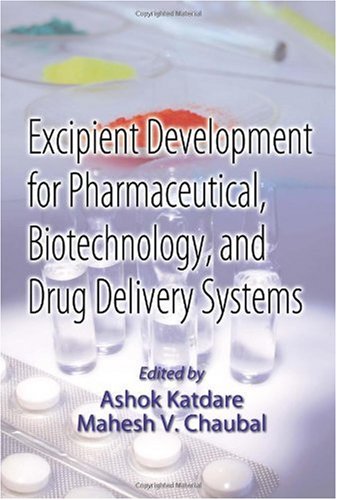We certainly hope that this book will encourage regulatory authorities to
develop new regulatory processes for independent review and use of excipients.
The availability of independent review will encourage innovation and development
of commercially viable new excipients. Ultimately, all this should help quickly
develop lifesaving drug delivery systems benefiting humans.
Ashok Katdare
Mahesh V. Chaubal
Preface
To facilitate the development of novel drug delivery systems and biotechnologyderived
drugs, the need for new excipients continues to increase. This book Excipient
Development for Pharmaceutical, Biotechnology, and Drug Delivery Systems serves as
a comprehensive source to improve understanding of excipients and forge new
avenues to promote independent regulatory review and development of novel excipients.
In addition, this book presents in-depth information on various aspects of
excipient development, safety/toxicology testing, regulatory processes, quality,
manufacturability, and the utility of excipients for various drug delivery systems.
We have relied on numerous experts and thought leaders from all over the world
who have shared their expertise and time to prepare the chapters included in this
book. Each chapter also provides a wealth of useful references that should prove
to be invaluable for the reader.
This book is intended for formulation scientists, analytical scientists and
engineers, regulatory and compendia personnel, procurement personnel, preclinical
scientists, excipient manufacturers, quality control and assurance personnel, and
distributors.
What makes this book so timely? In recent years, an awareness and understanding
of excipients has increased based upon several important factors.
First, as pharmaceutically active ingredients continue to become more ‘‘potent,’’
the effective doses have become smaller. As a result, excipients now often constitute the
major portion of many pharmaceutical dosage forms and as such can have profound
impact on the reproducibility of manufacture and overall quality of the dosage forms.
Second, regulatory authorities, especially the U.S. Food and Drug Administration,
have clearly set an expectation that quality should be built in drug products
from the beginning of development and manufacture rather than simply testing
quality of the finished product (quality for 21st century initiative). This stance has
forced the industry and academia to develop a thorough understanding of the
functionalities and modalities of excipients, as well as to develop and adopt testing
methodologies from other industries to refine the characterization of excipients.
Also, increased use of process analytical technologies has helped excipient manufacturers
and users to develop improved in-process controls and better-controlled
manufacturing processes. These efforts should enhance building quality in the manufacture
of drug products.
Excipients: Background/Introduction
Lokesh Bhattacharyya, Stefan Schuber, Catherine Sheehan,
and Roger William
Department of Standards Development, United States Pharmacopeia,
Rockville, Maryland, U.S.A.
Almost all therapeutic products, including therapeutic products for human and
veterinary use, include excipients—indeed, the total amount of excipients frequently
used is greater than the amount of the active drug substance(s) in a dosage form. As
with drug substances, excipients are derived from natural sources or are synthesized
either chemically or by other means. They range from simple, usually highly characterized,
organic, or inorganic molecules to highly complex materials that are difficult
to fully characterize.
In earlier days, excipients were considered inactive ingredients. Over time,
pharmaceutical scientists learned that excipients are not inactive and frequently have
substantial impact on the manufacture and quality, safety, and efficacy of the drug
substance(s) in a dosage form. Further, variability in the performance of an excipient—both
batch to batch within a single manufacturer as well as between batches
from different manufacturers—came to be understood as a key determinant of
dosage form performance. Excipients are now known to have defined functional
roles in pharmaceutical dosage forms. These include (i) modulating solubility and
bioavailability of the active ingredient(s); (ii) enhancing stability of the active ingredient(s)
in finished dosage forms; (iii) helping active ingredients maintain a preferred
polymorphic form or conformation; (iv) maintaining pH and osmolarity of liquid
formulations; (v) acting as antioxidants, emulsifying agents, aerosol propellants,
tablet binders, and tablet disintegrants; (vi) preventing aggregation or dissociation;
and (vii) modulating the immunogenic response of active ingredients (e.g., adjuvants)
and many others. United States Pharmacopeia 28–National Formulary 23 lists
40 functional categories of excipients for pharmaceuticals, and many more are
expected as new—and usually increasingly complex—drug-delivery systems emerge
and evolve. Approximately 800 excipients are currently used in the marketed pharmaceutical
products in the United States. This number is also expected to grow with
new therapeutic categories, such as gene therapy and cell therapy, and new drugdelivery
technologies
Lokesh Bhattacharyya, Stefan Schuber, Catherine Sheehan,
and Roger William
Department of Standards Development, United States Pharmacopeia,
Rockville, Maryland, U.S.A.
Almost all therapeutic products, including therapeutic products for human and
veterinary use, include excipients—indeed, the total amount of excipients frequently
used is greater than the amount of the active drug substance(s) in a dosage form. As
with drug substances, excipients are derived from natural sources or are synthesized
either chemically or by other means. They range from simple, usually highly characterized,
organic, or inorganic molecules to highly complex materials that are difficult
to fully characterize.
In earlier days, excipients were considered inactive ingredients. Over time,
pharmaceutical scientists learned that excipients are not inactive and frequently have
substantial impact on the manufacture and quality, safety, and efficacy of the drug
substance(s) in a dosage form. Further, variability in the performance of an excipient—both
batch to batch within a single manufacturer as well as between batches
from different manufacturers—came to be understood as a key determinant of
dosage form performance. Excipients are now known to have defined functional
roles in pharmaceutical dosage forms. These include (i) modulating solubility and
bioavailability of the active ingredient(s); (ii) enhancing stability of the active ingredient(s)
in finished dosage forms; (iii) helping active ingredients maintain a preferred
polymorphic form or conformation; (iv) maintaining pH and osmolarity of liquid
formulations; (v) acting as antioxidants, emulsifying agents, aerosol propellants,
tablet binders, and tablet disintegrants; (vi) preventing aggregation or dissociation;
and (vii) modulating the immunogenic response of active ingredients (e.g., adjuvants)
and many others. United States Pharmacopeia 28–National Formulary 23 lists
40 functional categories of excipients for pharmaceuticals, and many more are
expected as new—and usually increasingly complex—drug-delivery systems emerge
and evolve. Approximately 800 excipients are currently used in the marketed pharmaceutical
products in the United States. This number is also expected to grow with
new therapeutic categories, such as gene therapy and cell therapy, and new drugdelivery
technologies




